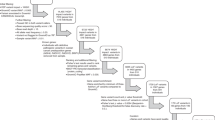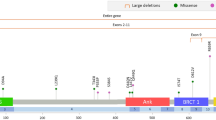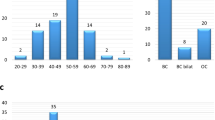Abstract
Ovarian cancer causes more deaths than any other gynecologic malignancy in developed countries. Sixteen million sequence variants, identified through whole-genome sequencing of 457 Icelanders, were imputed to 41,675 Icelanders genotyped using SNP chips, as well as to their relatives. Sequence variants were tested for association with ovarian cancer (N of affected individuals = 656). We discovered a rare (0.41% allelic frequency) frameshift mutation, c.2040_2041insTT, in the BRIP1 (FANCJ) gene that confers an increase in ovarian cancer risk (odds ratio (OR) = 8.13, P = 2.8 × 10−14). The mutation was also associated with increased risk of cancer in general and reduced lifespan by 3.6 years. In a Spanish population, another frameshift mutation in BRIP1, c.1702_1703del, was seen in 2 out of 144 subjects with ovarian cancer and 1 out of 1,780 control subjects (P = 0.016). This allele was also associated with breast cancer (seen in 6/927 cases; P = 0.0079). Ovarian tumors from heterozygous carriers of the Icelandic mutation show loss of the wild-type allele, indicating that BRIP1 behaves like a classical tumor suppressor gene in ovarian cancer.
This is a preview of subscription content, access via your institution
Access options
Subscribe to this journal
Receive 12 print issues and online access
$209.00 per year
only $17.42 per issue
Buy this article
- Purchase on Springer Link
- Instant access to full article PDF
Prices may be subject to local taxes which are calculated during checkout

Similar content being viewed by others
References
Ferlay, J. et al. Estimates of worldwide burden of cancer in 2008: GLOBOCAN 2008. Int. J. Cancer 127, 2893–2917 (2010).
Stratton, J.F., Pharoah, P., Smith, S.K., Easton, D. & Ponder, B.A. A systematic review and meta-analysis of family history and risk of ovarian cancer. Br. J. Obstet. Gynaecol. 105, 493–499 (1998).
Rafnar, T. et al. BRCA2, but not BRCA1, mutations account for familial ovarian cancer in Iceland: a population-based study. Eur. J. Cancer 40, 2788–2793 (2004).
Ramus, S.J. & Gayther, S.A. The contribution of BRCA1 and BRCA2 to ovarian cancer. Mol. Oncol. 3, 138–150 (2009).
Malander, S. et al. The contribution of the hereditary nonpolyposis colorectal cancer syndrome to the development of ovarian cancer. Gynecol. Oncol. 101, 238–243 (2006).
Rubin, S.C. et al. BRCA1, BRCA2, and hereditary nonpolyposis colorectal cancer gene mutations in an unselected ovarian cancer population: relationship to family history and implications for genetic testing. Am. J. Obstet. Gynecol. 178, 670–677 (1998).
Song, H. et al. A genome-wide association study identifies a new ovarian cancer susceptibility locus on 9p22.2. Nat. Genet. 41, 996–1000 (2009).
Goode, E.L. et al. A genome-wide association study identifies susceptibility loci for ovarian cancer at 2q31 and 8q24. Nat. Genet. 42, 874–879 (2010).
Bolton, K.L. et al. Common variants at 19p13 are associated with susceptibility to ovarian cancer. Nat. Genet. 42, 880–884 (2010).
Kong, A. et al. Detection of sharing by descent, long-range phasing and haplotype imputation. Nat. Genet. 40, 1068–1075 (2008).
Holm, H. et al. A rare variant in MYH6 is associated with high risk of sick sinus syndrome. Nat. Genet. 43, 316–320 (2011).
Sulem, P. et al. Identification of low-frequency variants associated with gout and serum uric acid levels. Nat. Genet. (in the press).
Thorlacius, S. et al. A single BRCA2 mutation in male and female breast cancer families from Iceland with varied cancer phenotypes. Nat. Genet. 13, 117–119 (1996).
Cantor, S.B. et al. BACH1, a novel helicase-like protein, interacts directly with BRCA1 and contributes to its DNA repair function. Cell 105, 149–160 (2001).
Litman, R. et al. BACH1 is critical for homologous recombination and appears to be the Fanconi anemia gene product FANCJ. Cancer Cell 8, 255–265 (2005).
Levitus, M. et al. The DNA helicase BRIP1 is defective in Fanconi anemia complementation group J. Nat. Genet. 37, 934–935 (2005).
Levran, O. et al. The BRCA1-interacting helicase BRIP1 is deficient in Fanconi anemia. Nat. Genet. 37, 931–933 (2005).
Seal, S. et al. Truncating mutations in the Fanconi anemia J gene BRIP1 are low-penetrance breast cancer susceptibility alleles. Nat. Genet. 38, 1239–1241 (2006).
Sarantaus, L. et al. Multiple founder effects and geographical clustering of BRCA1 and BRCA2 families in Finland. Eur. J. Hum. Genet. 8, 757–763 (2000).
Cantor, S.B. & Guillemette, S. Hereditary breast cancer and the BRCA1-associated FANCJ/BACH1/BRIP1. Future Oncol. 7, 253–261 (2011).
Yu, X., Chini, C.C., He, M., Mer, G. & Chen, J. The BRCT domain is a phospho-protein binding domain. Science 302, 639–642 (2003).
Kumaraswamy, E. & Shiekhattar, R. Activation of BRCA1/BRCA2-associated helicase BACH1 is required for timely progression through S phase. Mol. Cell. Biol. 27, 6733–6741 (2007).
Bridge, W.L., Vandenberg, C.J., Franklin, R.J. & Hiom, K. The BRIP1 helicase functions independently of BRCA1 in the Fanconi anemia pathway for DNA crosslink repair. Nat. Genet. 37, 953–957 (2005).
Godwin, A.K. et al. A common region of deletion on chromosome 17q in both sporadic and familial epithelial ovarian tumors distal to BRCA1. Am. J. Hum. Genet. 55, 666–677 (1994).
Tavtigian, S.V. et al. The complete BRCA2 gene and mutations in chromosome 13q-linked kindreds. Nat. Genet. 12, 333–337 (1996).
Wetzels, J.F., Kiemeney, L.A., Swinkels, D.W., Willems, H.L. & den Heijer, M. Age- and gender-specific reference values of estimated GFR in Caucasians: the Nijmegen Biomedical Study. Kidney Int. 72, 632–637 (2007).
Li, H. & Durbin, R. Fast and accurate short read alignment with Burrows-Wheeler transform. Bioinformatics 25, 1754–1760 (2009).
Marchini, J., Howie, B., Myers, S., McVean, G. & Donnelly, P. A new multipoint method for genome-wide association studies by imputation of genotypes. Nat. Genet. 39, 906–913 (2007).
Kong, A. et al. A high-resolution recombination map of the human genome. Nat. Genet. 31, 241–247 (2002).
Acknowledgements
This work was partly funded by the European Commission 7th Framework Programme FP7-MC-IAPP (grant agreement no. 218071 CancerGene).
Author information
Authors and Affiliations
Contributions
The study was designed and supervised by T.R., D.F.G., P.S., U.T. and K.S. Statistical analysis was carried out by D.F.G, P.S., S.B. and A.K. Patient ascertainment, recruitment, biological material collection and collection of clinical and lifestyle information was organized and carried out by L.T., J.G.J., A.d.J., E.O., J.M.R.-C., M.D.G.-P., C.M., A.P., F.R., K.K.H.A., A.M.v.A., L.F.A.G.M., M.A., P.M.K., S.S., L.A.A., K. Olafsdottir, J.B., A. Salvarsdottir, H.S., K. Olafsson, K.R.B., J. Gulcher, L.A.K. and J.I.M. Principal investigators for the follow up populations were J.I.M. (Spain), L.A.K. (Netherlands) and L.A.A. and S.S. (Finland). Genotyping and laboratory experiments were designed and carried out by Aslaug Jonasdottir, Adalbjorg Jonasdottir, A. Sigurdsson, S.N.S., J. Gudmundsson, O.T.M., L.l.R., G.O., H.T.H. and H.J. Bioinformatics analysis was carried out by A.G., P.L. and G.M. Authors T.R., D.F.G., P.S., U.T. and K.S. wrote the manuscript. All authors contributed to the final version of the paper.
Corresponding authors
Ethics declarations
Competing interests
Some of the authors employed by deCODE genetics own stock or stock options in the company.
Supplementary information
Supplementary Text and Figures
Supplementary Note, Supplementary Tables 1–9 and Supplementary Figures 1–3 (PDF 1632 kb)
Rights and permissions
About this article
Cite this article
Rafnar, T., Gudbjartsson, D., Sulem, P. et al. Mutations in BRIP1 confer high risk of ovarian cancer. Nat Genet 43, 1104–1107 (2011). https://doi.org/10.1038/ng.955
Received:
Accepted:
Published:
Issue Date:
DOI: https://doi.org/10.1038/ng.955
This article is cited by
-
Fanconi Anemia Complementary Group A (FANCA) Facilitates the Occurrence and Progression of Liver Hepatocellular Carcinoma
Digestive Diseases and Sciences (2024)
-
Extended genetic analysis and tumor characteristics in over 4600 women with suspected hereditary breast and ovarian cancer
BMC Cancer (2023)
-
Multimolecular characteristics and role of BRCA1 interacting protein C-terminal helicase 1 (BRIP1) in human tumors: a pan-cancer analysis
World Journal of Surgical Oncology (2023)
-
Spectrum of BRCA1 interacting helicase 1 aberrations and potential prognostic and therapeutic implication: a pan cancer analysis
Scientific Reports (2023)
-
Deficit of homozygosity among 1.52 million individuals and genetic causes of recessive lethality
Nature Communications (2023)



